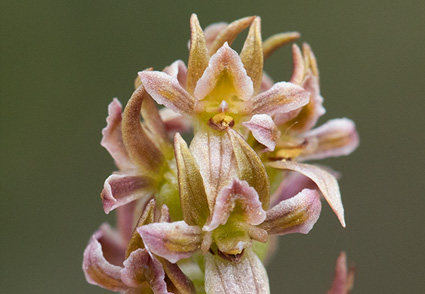Abstract
Prasophyllum morganii (Orchidaceae), the mignonette leek orchid, was first collected from a single population in the subalps of Victoria, Australia, in 1929 but has not been collected since 1933. A morphologically similar leek orchid, P. retroflexum, was described in 2000 from Kosciuszko National Park, New South Wales, Australia. We measured 51 morphological traits on 14 field collected and 13 herbarium specimens of P. retroflexum, and six historical herbarium collections of P. morganii. In addition, we conducted a comparison of the types of both species with the field and herbarium specimens. Multivariate analyses were undertaken using 35 characters, and an ordination performed on range-standardised data. Results show no morphological differences between specimens identified as P. morganii and P. retroflexum, and we conclude they are conspecific.
References
<p>Backhouse, G., Kosky, B., Rouse, D. & Turner, J. (2016) <em>Bush gems, a guide to the wild orchids of Victoria, Australia</em>. E-Book, Melbourne. </p>
<p>Bates, R.J. (1994) <em>Prasophyllum</em>. <em>In:</em> Walsh, N.G. & Entwisle, T.J. (Eds.) <em>Flora of Victoria, </em>vol. 2. <em>Ferns and allied plants, conifers and monocotyledons</em>. Inkata Press, Melbourne, 869 pp.</p>
<p>Belbin, L. (1990) <em>PATN: pattern analysis package</em>. Division of Wildlife and Ecology, CSIRO, Australia. Available from: https://patn.org (accessed 11 June 2021)</p>
<p>Brown, R. (1810) <em>Prodromus florae Novae Hollandiae et Insulae Van-Diemens. </em>Taylor & Son, London, 357 pp. </p>
<p>Clements, M.A. & Jones, D.L. (2019) Notes on Australasian Orchids 5: <em>Paraprasophyllum</em>, a new genus in Prasophyllinae (Diurideae). <em>Australian Orchid Review</em> 84: 24–38. </p>
<p>Coates, F. (2003) <em>Action statement: mignonette leek orchid, Prasophyllum morganii.</em> Department of Sustainability and Environment, Victoria.</p>
<p>Department of Environment and Primary Industries (2014) <em>Advisory list of rare or threatened plants in Victoria – 2014</em>. The State of Victoria, Melbourne, 59 pp.</p>
<p>Department of Planning, Industry and Environment (2014) <em>Saving our species: help save the Kiandra leek orchid. </em>Department of Planning, Industry and Environment, New South Wales.</p>
<p>Federal Register of Legislation of Australia (2021) <em>Environment Protection and Biodiversity Conservation Act 1999</em> (Cwlth). Legislation enacted by the Parliament of Australia. Available from: https://www.legislation.gov.au/Series/C2004A00485 (accessed 12 May 2021)</p>
<p>IUCN (2012) <em>IUCN Red List categories and criteria, </em>version 3.1, second edition. Gland and Cambridge, IUCN Species Survival Commission.</p>
<p>Jones, D.L. (2000) Ten new species of <em>Prasophyllum</em> (Orchidaceae) from south-eastern Australia. <em>The Orchadian</em> 13: 149–173.</p>
<p>Jones, D.L. (2001) <em>Prasophyllum</em>. <em>In. </em>Pridgeon, A.M., Cribb, P.J., Rasmussen, F.N. & Chase, M.W. (Eds.) <em>Genera orchidacearum. </em>vol. 2<em>. Orchidoideae </em>(part 1). Oxford University Press, Oxford, pp. 186–193.</p>
<p>Jones, D.L. (2021) <em>A complete guide to native orchids of Australia,</em> 3<sup>rd</sup> edition. Reed New Holland, Sydney, 800 pp.</p>
<p>Loudon, J.C. (1830) <em>Hortus Britannicus. A catalogue of all the plants indigenous, cultivated in, or introduced to Britain</em>. Longman, London, 269 pp. https://doi.org/10.5962/bhl.title.10320</p>
<p>Nicholls, W.H. (1930) A new <em>Prasophyllum.</em> <em>Victorian Naturalist</em> 46: 179–180.</p>
<p>Nicholls, W.H. (1969) <em>The complete orchids of Australia</em>. Nelson, Melbourne, 44 pp.</p>
<p>QGIS.org. (2021) QGIS Geographic Information System. QGIS Association. Available from: http://www.qgis.org (accessed 13 December 2021)</p>
<p>R Development Core Team. (2020) <em>R: a language and environment for statistical computing</em>. R Foundation for Statistical Computing, Vienna, Austria. Available from: https://cran.r-project.org/bin/windows/base/ (accessed 11 June 2021)</p>
<p>Rueden, C.T., Schindelin, F., Hiner, M.C., DeZonia, B.E., Walter, A.E., Arena, E.T. & Eliceiri, K.W. (2017) ImageJ2: ImageJ for the next generation of scientific image data<em>.</em> <em>BMC Bioinformatics</em> 18: 1–26. https://doi.org/10.1186/s12859-017-1934-z</p>
<p>Threatened Species Scientific Committee (2016) <em>Conservation Advice Prasophyllum morganii Cobungra leek-orchid.</em> Department of the Environment and Energy, Canberra.</p>
<p>VicFlora. (2021) <em>Flora of Victoria</em>. Royal Botanic Gardens Victoria. Available from: http://vicflora.rbg.vic.gov.au (accessed 11 June 2021)</p>


